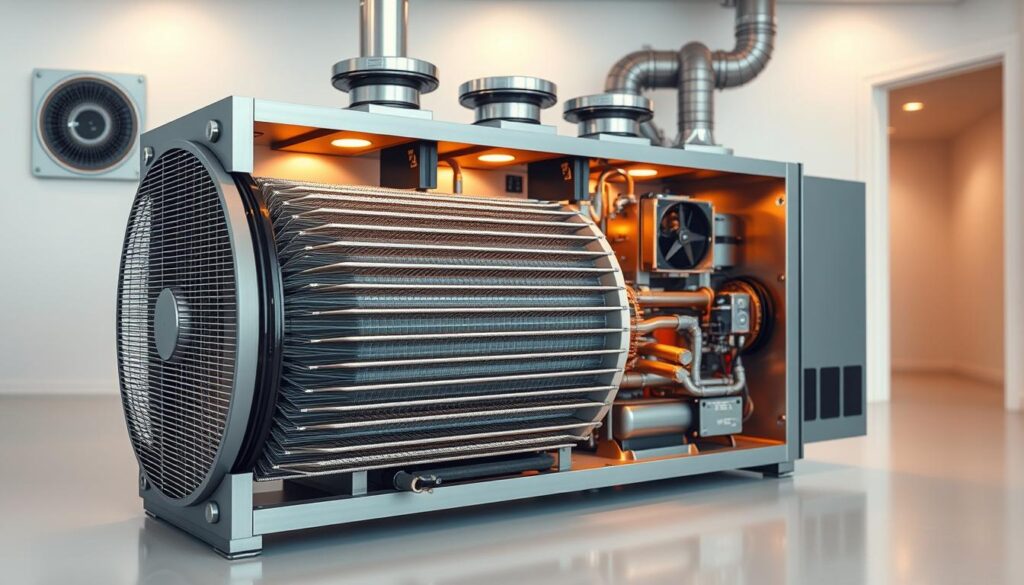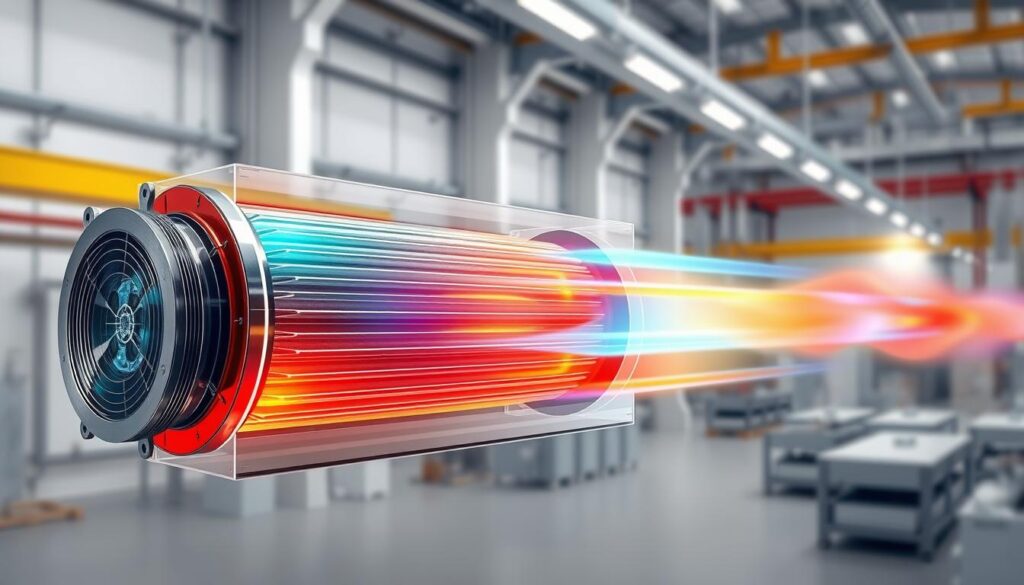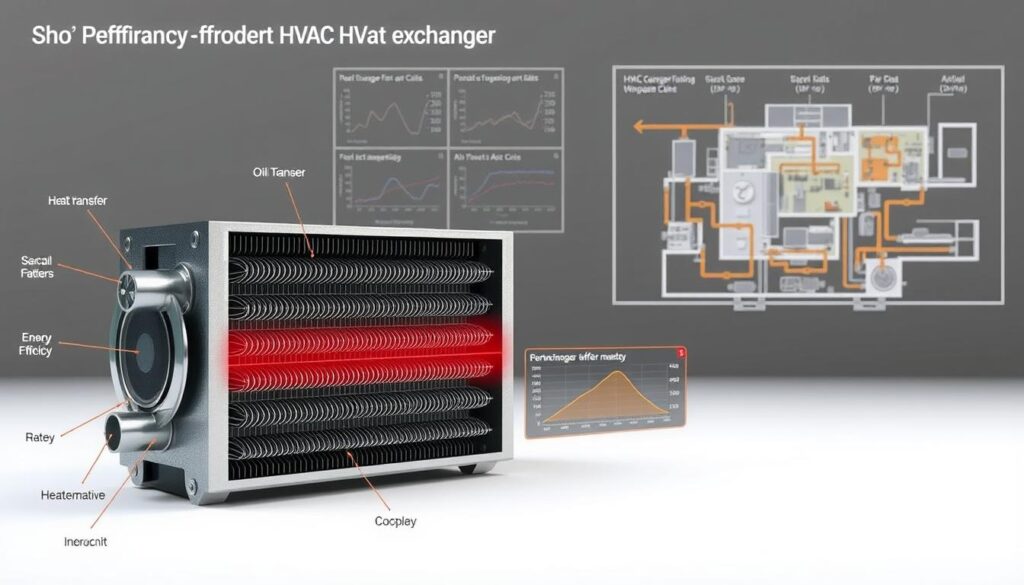Affiliate Disclosure
HVAC Guide Guys is a participant in the Amazon Services LLC Associates Program, an affiliate advertising program designed to provide a means for sites to earn advertising fees by advertising and linking to Amazon.
What Is a Heat Exchanger HVAC? A heat exchanger is key for moving heat between different air or fluid streams. Your HVAC system uses this tech to keep your home comfy and save energy.

Ever wondered how your home stays just the right temperature? It’s thanks to a cool device called a heat exchanger in HVAC systems.
Learning about heat exchangers in heating systems shows the amazing engineering in your home’s climate control. It works quietly, moving heat where it’s needed. This keeps your home cozy all year.
Key Takeaways
- Heat exchangers are essential for efficient temperature regulation
- They facilitate thermal energy transfer in HVAC systems
- Enables precise indoor climate control
- Improves overall energy efficiency
- Critical for both heating and cooling processes
Table of Contents
Understanding HVAC Heat Exchangers
Heat exchangers are key parts of HVAC systems. They help control temperatures efficiently. They transfer heat between different mediums, making indoor spaces comfortable. Knowing how they work shows the advanced engineering in heating and cooling systems.
Heat exchangers’ main job is to move thermal energy from one fluid to another without touching. This method allows for exact temperature control in homes and businesses.
Basic Principles of Heat Transfer
Heat transfer in HVAC systems happens in three main ways:
- Conduction: Direct heat transfer through solid materials
- Convection: Heat movement through liquids and gases
- Radiation: Heat transfer through electromagnetic waves
Role in HVAC Systems
The efficiency of HVAC heat exchangers depends on several important factors. They manage thermal energy by:
- Capturing heat from combustion processes
- Transferring warmth between air and refrigerant
- Maintaining optimal temperature gradients
Components and Construction
Modern heat exchangers use advanced materials for better performance. They are made with metal plates or tubes to increase surface area and heat transfer rates.
Efficient heat exchangers can greatly cut down energy use and boost HVAC system performance.
Explore Our HVAC Shop
Looking for top-rated HVAC tools, parts, and accessories? Visit our shop and find the perfect solution for your needs.
Visit the ShopTypes of Heat Exchangers in HVAC Systems
Heat exchangers are key in HVAC systems. They move thermal energy between fluids. Knowing the different types can improve your system’s performance and efficiency.
Each heat exchanger design has its own role in heating, cooling, and ventilation. Let’s look at the most common types in today’s HVAC systems:
Plate and Frame Heat Exchangers
Plate heat exchangers are great for small spaces. They use thin metal plates for efficient heat transfer. Their benefits include:
- Extremely efficient thermal transfer
- Minimal space requirements
- Easy maintenance and cleaning
- Adaptable to various temperature ranges
Shell and Tube Heat Exchangers
Shell and tube designs are strong for big HVAC systems. One fluid goes through tubes, and another flows around the shell. This setup is efficient for heat exchange.
These heat exchangers are best for:
- High-pressure operations
- Extreme temperature differences
- Handling multiple fluid types
Finned Tube Heat Exchangers
Finned tube heat exchangers work well for air-to-fluid heat transfer. The metal fins increase the surface area for better heat exchange. They’re great for:
- Air conditioning systems
- Refrigeration units
- Heating and cooling networks
When picking heat exchangers for HVAC, think about space, thermal needs, and system complexity. Choose the best design for your needs.
What Is a Heat Exchanger HVAC
A heat exchanger in HVAC systems is key for managing thermal energy transfer. It keeps your indoor temperature comfy while making your heating system safe and efficient.
The heat exchanger function in heating systems involves several key processes:
- Transferring heat from combustion sources to circulating air
- Creating a protective barrier between combustion chambers and living spaces
- Preventing direct contact between fuel combustion products and breathable air
Exploring what is a heat exchanger HVAC shows it’s like a thermal bridge. In a typical furnace, it captures warmth from burning fuel. Then, it safely spreads it through your home without mixing harmful gases with air you breathe.
The design of a heat exchanger is simple yet effective. Metal chambers or tubes absorb heat from fuel. Then, they warm the air that flows through your home’s ductwork. This way, you get clean, warm air while keeping dangerous gases out.
“A heat exchanger transforms raw thermal energy into comfortable, safe indoor temperatures.” – HVAC Engineering Principles
Today’s heat exchangers are made for top efficiency. They use advanced materials and precise manufacturing. This makes heat transfer better and energy loss less.
Explore Our HVAC Shop
Looking for top-rated HVAC tools, parts, and accessories? Visit our shop and find the perfect solution for your needs.
Visit the ShopHeat Exchanger Working Principles
Understanding HVAC heat exchangers is key to keeping your home comfy. These devices move heat between two mediums without touching, making heating and cooling efficient.

The heart of HVAC heat exchanger efficiency is three main heat transfer ways:
- Conduction: Direct heat transfer through solid materials
- Convection: Heat movement through fluid or air circulation
- Radiation: Heat transfer through electromagnetic waves
Heat Transfer Methods
In HVAC systems, heat exchangers use these methods to move heat. Conduction happens when heat goes through metal. Convection spreads warm or cool air in your home.
Fluid Flow Dynamics
Heat exchanger efficiency relies on fluid flow patterns. There are two main types:
| Flow Type | Characteristics | Efficiency |
|---|---|---|
| Counterflow | Fluids move in opposite directions | High heat transfer rate |
| Parallel Flow | Fluids move in same direction | Lower heat transfer rate |
Temperature Differential Process
Heat always moves from warmer to cooler areas. HVAC heat exchangers use this principle to move heat efficiently.
“The magic of heat exchangers lies in their ability to move heat without mixing different air streams.” – HVAC Engineering Principles
Applications in Modern HVAC Systems
Heat exchangers are key in modern HVAC systems. They help manage temperature and keep indoor spaces comfortable. They are used in homes and big buildings, changing how we control temperature.
In homes, coil heat exchangers for air conditioning are very important. They move heat between inside and outside, keeping your home at the right temperature. These systems work well in:
- Central air conditioning units
- Residential heat pump systems
- Furnace heating mechanisms
- Geothermal cooling installations
Big buildings and factories use advanced heat exchanger tech. They need systems that can handle big thermal loads and save energy. Precision engineering makes this possible.
Heat exchangers also have special uses. For example, they help save energy in ventilation systems. They can even use natural heat from the ground for heating and cooling.
Modern heat exchangers are not just about temperature control—they’re about intelligent, energy-efficient thermal management.
Choosing the right heat exchanger depends on many factors. It’s about the environment, space, and how well it works. Knowing about different types is important for the best performance.
Explore Our HVAC Shop
Looking for top-rated HVAC tools, parts, and accessories? Visit our shop and find the perfect solution for your needs.
Visit the ShopEfficiency and Performance Factors
Knowing about hvac heat exchanger efficiency is key to better heating system performance. The heat exchanger’s role in heating systems affects energy use and system success.

Your HVAC system’s efficiency comes from several important metrics. These metrics show how well heat is moved and used. Let’s look at the main factors that affect heat exchanger performance.
Energy Transfer Rates
Energy transfer rates are key to understanding heat exchanger efficiency. They show how fast and well heat moves between different parts of your HVAC system.
- Thermal conductivity of materials
- Surface area of heat exchange
- Temperature difference between fluids
- Flow rates of heating and cooling mediums
System Optimization Techniques
To improve your heat exchanger, use strategic methods:
- Proper sizing of heat exchange parts
- Regular maintenance and cleaning
- Choosing high-performance materials
- Reducing thermal resistance
Performance Metrics
| Metric | Description | Importance |
|---|---|---|
| Effectiveness | Ratio of actual heat transfer to maximum possible heat transfer | Shows system efficiency |
| Overall Heat Transfer Coefficient | Measure of heat transfer through materials | Helps evaluate component performance |
| Number of Transfer Units (NTU) | Dimensionless parameter describing heat exchanger capacity | Helps compare different heat exchanger designs |
By knowing these efficiency and performance factors, you can make smart choices about your HVAC system’s heat exchanger. This ensures the best energy use and long-term reliability.
Maintenance and Troubleshooting
Keeping your HVAC heat exchanger in good shape is key to a long-lasting and efficient heating system. Knowing what a heat exchanger in HVAC means helps you see why regular care and catching problems early are so important.
Your heat exchanger needs regular care to avoid breakdowns and keep it running well. Important maintenance steps include:
- Annual professional inspections
- Regular filter replacements
- Cleaning surrounding equipment
- Monitoring system performance
Both you and a certified HVAC technician play a role in maintenance. You should do routine checks and clean up right away. But, for complex issues, it’s best to call in the pros.
Look out for these signs of heat exchanger trouble:
- Unusual noises during operation
- Inconsistent heating or cooling
- Visible cracks or corrosion
- Reduced system efficiency
Regular maintenance can make your heat exchanger last longer. Make sure to get professional checks at least once a year. This way, you can catch problems before they turn into expensive fixes.
Remember: Early detection and consistent care are your best defense against heat exchanger failures.
Explore Our HVAC Shop
Looking for top-rated HVAC tools, parts, and accessories? Visit our shop and find the perfect solution for your needs.
Visit the ShopCommon Issues and Solutions
Your HVAC heat exchanger is key to your system’s health. It needs regular care and quick fixes to avoid big problems. Knowing common issues helps keep your system running smoothly.
Identifying Critical Problems
Spotting early signs is vital for HVAC care. Look out for these red flags:
- Unusual flame color or patterns
- Persistent strange odors near your HVAC system
- Visible cracks or corrosion
- Soot accumulation around equipment
- Carbon monoxide detector alerts
Preventive Maintenance Strategies
Keeping your systems safe needs a plan:
- Schedule annual professional inspections
- Clean heat exchangers regularly
- Monitor system performance consistently
- Replace air filters quarterly
- Check for possible refrigerant leaks
Replacement Considerations
Some problems mean you need a new heat exchanger. Signs include major corrosion, many cracks, or ongoing issues that can’t be fixed. A pro can tell if you need a fix or a new one.
“Proactive maintenance prevents expensive emergency replacements and ensures optimal HVAC system performance.” – HVAC Industry Expert
Learning about maintenance helps your HVAC last longer. It also saves energy and keeps your space comfy and safe.
Benefits of Modern Heat Exchanger Technology
Modern heat exchanger technology has changed how HVAC systems work. It brings unmatched efficiency to your home’s comfort and energy use. These new innovations can make a big difference.
New heat recovery ventilation systems offer great benefits for homes and businesses. They use advanced designs to transfer heat well and use less energy.
- Enhanced thermal performance with innovative materials
- Reduced energy consumption by up to 30%
- Improved durability and longer system lifespan
- Lower operational costs
Microchannel technology is a big step forward in heat exchanger design. It has tiny channels that increase surface area. This leads to better heat transfer and system performance.
“The future of HVAC efficiency lies in smart, adaptive heat exchanger technologies that respond dynamically to environmental conditions.” – HVAC Engineering Quarterly
Smart controls make your heat exchanger work better in real-time. They use advanced sensors and AI to adjust heat transfer quickly. This ensures top efficiency and comfort.
Choosing modern heat exchanger technology means choosing sustainable, cost-effective climate control. It combines smart design and advanced materials for eco-friendly and cost-effective HVAC solutions.
Conclusion
Knowing about heat exchanger HVAC systems is key for homeowners. They help keep your home at a comfortable temperature. These devices are great at moving heat from one place to another with high accuracy.
Heat exchangers play a big role in modern HVAC systems. They move heat from the combustion area to the air we breathe. This makes your home’s climate just right, saves energy, and cuts down on costs.
Learning about heat exchanger mechanics helps you make better choices. Regular checks and quick fixes keep your system running well. This means your home stays cozy, no matter the season.
As HVAC tech gets better, heat exchangers will keep being vital. They help make homes more energy-efficient and sustainable. By knowing about them, you can choose wisely for your comfort and the planet’s health.

